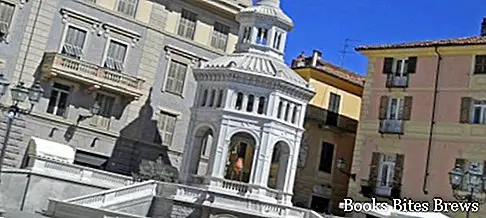What to see in Acqui Terme, itinerary of the main monuments and places of interest, including the Archaeological Museum, Paleologi Castle, La Bollente Fountain and the Duomo.
Tourist information
A town in Piedmont in the province of Alessandria, Acqui Terme is located in the upper Monferrato area, on the left bank of the Bormida river.
Aquae Statiellae was the name of the city founded by the Romans in the territory of the Statielli, a Ligurian population that was definitively defeated by the consul Marco Popilio Lenate in 173 BC.
The toponym of Aquae Statiellae recalls the name of the original population and the famous thermal waters that flow in the area.
Of the Roman age, among other things, the remains of the thermal structures, the aqueduct and the theater are visible, monuments that testify to the importance reached by the Roman municipium between the first and third century AD.
The numerous finds from prehistoric and protohistoric times, Roman times, late ancient and medieval ages, found during excavations are now preserved in the Archaeological Museum at the Paleologi Castle, which is located in the highest and most panoramic part of the center historic, formed by Borgo Pisterna, the oldest inhabited center, Borgo San Pietro and Borgo Nuovo.
In the city center and beyond the Bormida river, thermal springs rich in healing properties gush out, used together with the mud in the spas of the New Baths, in the city center, and of the Ancient Baths, located beyond the Bormida.
The symbol of the city is the Fontana della Bollente, located in the homonymous square, an octagonal marble temple designed by Giovanni Ceruti and built in 1870, under which it flows, at a temperature of about 74 degrees centigrade and with a flow rate of 560 liters per minute, a natural source of salso-bromo-iodine sulphurous water.
What see
To the left of the square, passing under the Medieval Clock Tower, erected without foundations above a door of the ancient city wall, you reach Corso Italia and then to Piazza San Francesco, where there is the nineteenth-century Fontana della Rocca and the Church convent of San Francesco of fifteenth-century origin, but remodeled in the mid-nineteenth century.
Almost in front of the Church there is the small Piazza Abram Levi with the Palazzo Comunale, the home of the Counts Lupi di Mirano dating back to the end of the seventeenth century, but remodeled later.
In Piazza Addolorata stands the Basilica of San Pietro-Addolorata, the oldest monument in the city, probably of early Christian origin and built in Romanesque forms on the foundations of the pre-existing place of worship.
Recommended readings- Alessandria (Piedmont): what to see in 1 day
- Langhe (Piedmont): what to see among castles, villages and vines
- Piedmont: Sunday day trips
- Oropa (Piedmont): what to see
- Cherasco (Piedmont): what to see
In 1718 Bishop Carlo Antonio Gozzanti restored the structure, divided the central nave and consecrated the Basilica to Our Lady of Sorrows.
The main nave, the octagonal Romanesque bell tower and the apses have come down to us from the original building.
In the scenic Piazza Duomo you can admire the Cathedral dedicated to the Assumption, consecrated in 1067 by San Guido, Bishop and Patron of the city.
The Romanesque building with a Latin cross plan with five naves, transformed over the centuries, retains part of the external structures, the transept and the semicircular apses of the primitive architecture.
The Chapter room houses the triptych of the Madonna del Monserrato, a masterpiece of the Spanish painter Bartolomeo Bermejo, made around 1480.
Adjacent to the Duomo stands the Bishop's Palace dating back to the fifteenth century.




